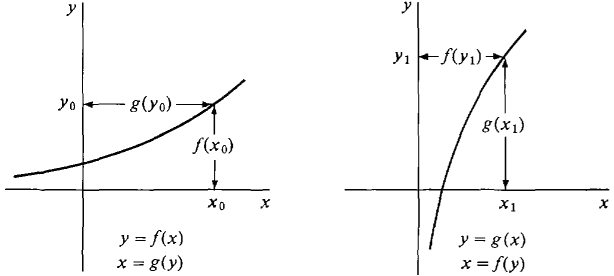| The ebook Elementary Calculus is based on material originally written by H.J. Keisler. For more information please read the copyright pages. |

|

Home  Differentiation Differentiation  Inverse Functions Inverse Functions  Inverse Functions Inverse Functions |
|






|
|
Inverse Functions
Two real functions f and g are called inverse functions if the two equations y = f(x), x = g(y) have the same graphs in the (x, y) plane. That is, a point (x, y) is on the curve y = f (x) if, and only if, it is on the curve x = g(y). (In general, the graph of the equation x = g(y) is different from the graph of y = g(x), but is the same as the graph of y = f(x); see Figure 2.4.1.)
Figure 2.4.1 Inverse Functions For example, the function y = x2, x ≥ 0, has the inverse function x = √y; the function y = x3 has the inverse function x= If we think of f as a black box operating on an input x to produce an output f(x), the inverse function g is a black box operating on the output f(x) to undo the work of f and produce the original input x (see Figure 2.4.2).
Figure 2.4.2
|
|
Home  Differentiation Differentiation  Inverse Functions Inverse Functions  Inverse Functions Inverse Functions |
|
Last Update: 2006-11-25




